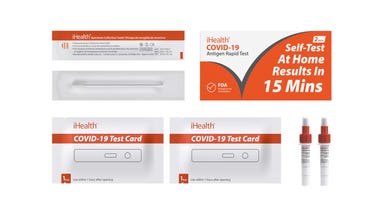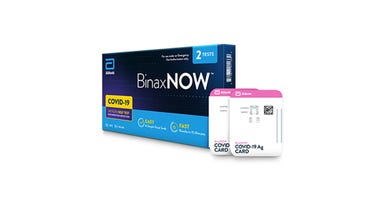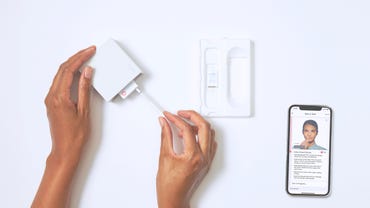
Written by
Jason Cipriani, Contributing Writer

Jason Cipriani
Contributing Writer
Jason Cipriani is based out of beautiful Colorado and has been covering technology news and reviewing the latest gadgets as a freelance journalist for the past 13 years. His work can be found all across the Internet and in print.
Full Bio
on December 10, 2021
| Topic: Digital Health and Wellness

iHealth COVID-19 Antigen Rapid Test
Affordable rapid tests for home or work
Jump to details
View now at iHealth Labs

BinaxNOW COVID-19 Antigen Rapid Self-Test at Home Kit
A commonly available rapid test
Jump to details
View now at Walmart

Cue Health COVID-19 Test
Pricey but more advanced and reliable
Jump to details
View now at Cue Health
After nearly two years, one thing is clear: COVID-19 isn’t going away anytime soon. One way to ease the mental stress and anxiety about whether or not that tickle in your throat, headache or fatigue is allergies or COVID-19 is to keep one of the best home covid tests on hand so you can easily test yourself.
There are plenty of options to get tested for COVID-19, ranging from free tests at a community testing center or your doctor’s office, but what about testing at home? Well, it turns out, there are plenty of options for that as well.
Below I’ve rounded up three different tests — all of which I’ve personally used. Each one will give you test results, and hopefully peace of mind, in 20 minutes or less. The first two tests are affordable and widely available rapid antigen tests, while the Cue Health test is more expensive, but the results can be used to clear you for travel or to meet work and school requirements.
The options listed below are currently approved by the FDA under an Emergency Use Authorization. I’ve linked to the available FDA report for each test’s accuracy when available.
iHealth COVID-19 Antigen Rapid Test
Affordable rapid tests for home or work

Image: iHealth Labs
Cost: $13.98 | Number of tests included: 2 | Time for results: 15 minutes | Positive Test Accuracy: 94.3% | Negative Test Accuracy: 98.1% |
iHealth recently started selling its at-home antigen rapid tests in a pack of two for $13.98. According to the FDA, the iHealth tests were 94.3% accurate in detecting a positive test result and 98.1% accurate when detecting negative test results.
Each test includes the nasal swab, an extraction tube and the test card. The card has two possible lines on it. The C line will always turn purple to show it’s a valid test. The T line will remain absent if it’s a negative result, or turn purple — matching the C line — if the test is positive.
You can download the iHealth COVID-19 Test app on your phone for detailed instructions and to store test results for yourself, family members or colleagues.
I’ve given or taken a few of these tests now and the process is easy, but a little confusing the first time due to how you transfer the sample from the swab to the tube. But once you get comfortable with the process, you’ll have no issues.
View now at iHealth Labs
View now at Amazon
BinaxNOW COVID-19 Antigen Rapid Self-Test at Home Kit
A commonly available rapid test

Image: Abbott
Cost: $23.99 | Number of tests included: 2 | Time for results: 15 minutes | Positive Test Accuracy: 91.7% | Negative Test Accuracy: 100% |
You may have heard of or seen the BinaxNOW test on store shelves. It’s $23.99 for a pack of two tests and can commonly be found at Walgreens, CVS, RiteAid and Walmart (the latter of which currently lists the test kit at $14).
Inside each box are two instruction sheets, two nasal swabs, two solution droppers and two test cards. Each card has two lines on it, one Control and one Sample. A purple line next to Control will always show up, while the Sample line is only visible if the test is positive.
I’ve administered and taken a handful of these tests, and they’re incredibly simple. I prefer this test process over the iHealth test kit simply because you don’t have to worry about properly transferring the sample. You only have to place the swab inside the card, twirl it a few times. However, while affordable, the price of this kit can add a layer of hesitation for frequent testing.
The companion app will walk you through the testing process and even record your results for you, giving you quick access to the last time you took a test and the accompanying results.
According to the FDA, BinaxNOW’s test results showed 91.7% accuracy for positive test samples and 100% accuracy for negative results.
View now at Walmart
Cue Health COVID-19 Test
Pricey but more advanced and reliable

Image: Cue
Cost: $225 | Number of tests included: 3 | Time for results: 20 minutes | Positive Test Accuracy: 97.8% | Negative Test Accuracy: 97.8% |
Cue Health’s COVID-19 Test is by far the most expensive test on this list. Each test cartridge is $75 and sold in packs of three or ten. In order to use the cartridges, you’ll need the $249 Cue Reader to process, analyze and transmit the results to your phone. You can buy a pack of 10 cartridges and the Cue Reader for $949.
Why so expensive? Unlike the iHealth and BinaxNOW test, Cue Health’s test isn’t a rapid antigen test. The test uses “nucleic acid amplification”, which is equivalent to a PCR test. PCR tests are the tests that you get at a doctor’s office or a community testing center and can take several hours or days to get your results.
Cue’s system gives you results in about 20 minutes.
An independent study by the Mayo Clinic found the Cue COVID test to be 97.8% accurate. Here’s the FDA report, as well.
Cue offers two different subscription plans for those who don’t want to spend a lot of money upfront for a Cue test system. For $49.99 per month, the Cue+ Essential plan gives you 10 tests per year, a $100 discount on the Cue Reader, and 24/7 access in the Cue Health app to primary care doctors.
For $89.99 a month, Cue+ Complete provides 20 tests per year, the same $100 discount on the Cue Reader, and — most importantly — the ability to take a supervised test at home. By taking a supervised test, your test results will be CDC-compliant and can be used to return to work, school, or to travel.
In other words, instead of going to the doctor to get a PCR test and waiting a couple of days for the results before you can go back to work, you can take a test at home and have the results in 20 minutes.
View now at Cue Health
Also worth considering
I’ve had some trouble finding the BinaxNOW test in stock at my local Walgreen’s, so if you run into issues finding a test, here are some other options that I haven’t personally used but have positive reviews on Amazon:
Quidel QuickVue at-home COVID-19 test: $24 on AmazonDexterity COVID-19 Saliva at-home collection PCR test — $99 on AmazonOn/Go at-home COVID-19 rapid antigen test — $30 on Amazon
What’s the difference between an antigen test and PCR test?
A PCR (polymerase chain reaction) test is the most accurate type of test for COVID-19. The results from a PCR test are often what’s required for work, school or travel. Depending on where you take the test, the results can take several days to come back. A PCR test looks for the genetic material of the virus.
Rapid antigen tests often produce results in 15 minutes but aren’t as accurate as a PCR test. The antigen test looks for the proteins of the virus. Antigen tests aren’t usually accepted for travel or admission to work or school.
Didn’t President Biden announce free at home tests?
Yes. However, it’s unclear how the program will work. Insurance companies will be required to cover the cost of at-home rapid tests, but you’ll most likely be required to pay for the tests upfront and then submit a reimbursement claim to your insurance company.
Until then, some tests are HSA/FSA eligible, including the Cue Health testing subscription and/or kits.
Which test is right for me?
Whichever test(s) are currently in stock and that you’re willing to pay for, at least until the free at-home testing program kicks off. The more proactive we all are with testing when we feel sick or after being around a large crowd, the better off we all.
Featured
Remote working: Five problems we need to solve in 2022
‘The Beatles: Get Back’ shows that deepfake tech isn’t always evil
Windows 11: Give yourself more time to roll back the upgrade
ZDNet’s 2021 holiday gift guide